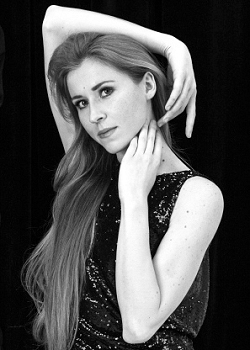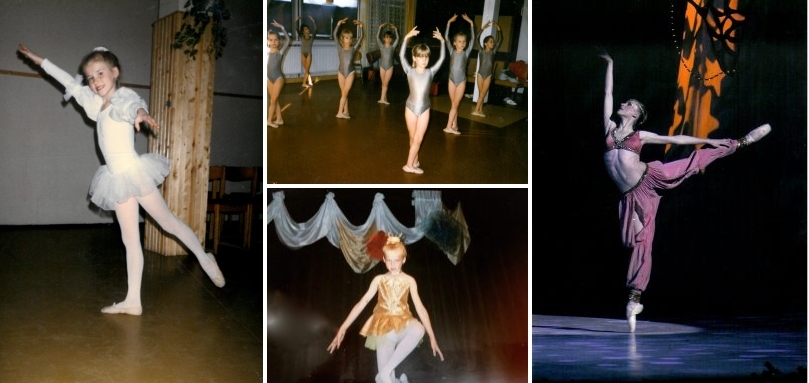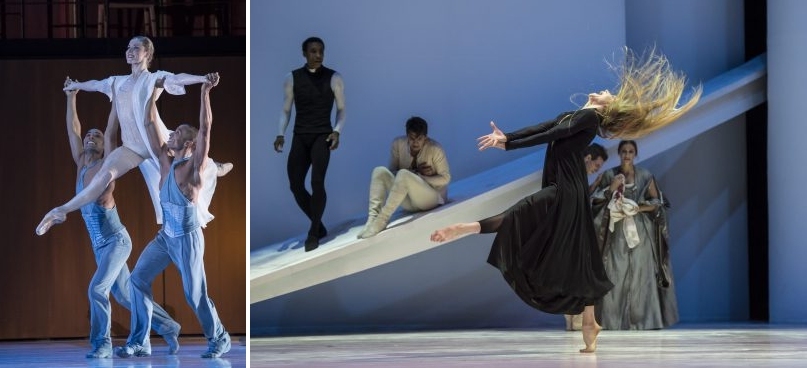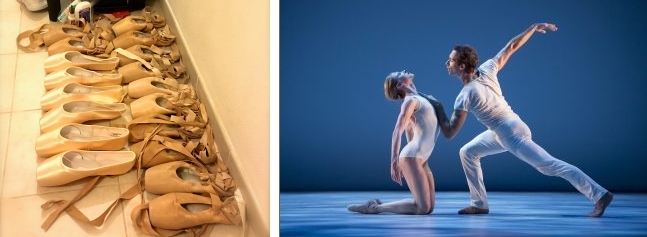General Articles
Marianna Barabas: Ballerina from the Siberian steppes to the Monaco shores
By Celina Lafuente de Lavotha - The Monaco Reporter
Insight into the life of a dancer
 Marianna Barabas, statuesque beautiful blond woman with piercing big blue eyes and a charming smile, is a principal soloist dancer with the Ballets de Monte-Carlo.
Marianna Barabas, statuesque beautiful blond woman with piercing big blue eyes and a charming smile, is a principal soloist dancer with the Ballets de Monte-Carlo.
(Photo left: By Intana Gagikovna Nahapetjan)
Marianna was born in Ust´-Ilimsk, near the ancient massive Baikal Lake considered the deepest in the world, in the mountainous region of Russia, the endless Siberian steppes, north of the Mongolian border. From a Russian mother, Valentyna, and a Hungarian father Mihàly, she is the middle of three sisters; Margarita the older and Evelin the youngest, who spent their childhood in Russia and later on moved with their family to Budapest, Hungary. Marianna agreed to a candid interview where she talked vividly about her passion for dancing, her career and dreams.
Dreams don't work if you don't
Marianna was only 3 years old when she started her first dance classes at a local dance studio under teacher Maria Csaky, and continued until the age of 9, when she was accepted at the Hungarian Dance Academy beginning her professional ballet training. It was very clear to her that she wanted to become a ballerina. “I had talent and was physically suitable for it, and most importantly I loved it very much, so there was no question that was the direction I wanted to go,” Marianne affirmed passionately.

After graduation she spent one season with the Hungarian National Ballet. From 2008 till 2014 Marianne joined the Royal Swedish Ballet in Stockholm as a soloist, dancing in roles from a vast classical repertoire; the Lilac Fairy in Sleeping Beauty (Marcia Haydee), the Snow Queen in The Nutcracker (Per Isberg), the Queen of the Sylphides in La Sylphide (Auguste Bournonville), the Queen of the Dryads and Kitri’s friends in Don Quixote (Rudolf Noureev), three large swans in Swan Lake (Natalia Conus), Rosaline in Romeo and Juliet (Kenneth McMillan), a courtesan in Manon (Kenneth McMillan), Pas de Trois in Raymonda (Pontus Lidberg).

She has also performed in more recent choreographies such as: Artifact (William Forsythe), Julia and Romeo (Mats Ek), Bill (Sharon Eyal), Altro Canto (Jean-Christophe Maillot), Midsummer Night’s Dream (Alexander Ekman), Les Noces (Angelin Preljocaj), Förlorad Tablå (Christian Spuck), Giselle (Natalia Makarova), The Rite of Spring (Maurice Bejárt), Onegin (John Cranko), Theme and Variations and Serenade (George Balanchine), Gustav III (Patrice Bart), and Coppelia (Marc Ribaud).
Joining the Ballets de Monte-Carlo – A rite of passage
In 2015 Marianna joined the Ballets de Monte-Carlo at the request of its Artistic Director Jean-Christophe Maillot, who she had had the chance to meet in Sweden 6 years earlier when she was 22 years old. She continues successfully working for the company as a principal soloist ballerina.
At the Ballets de Monte-Carlo Marianna has been dancing the leading roles of the Fairy Drosselmeyer in Casse-Noisette Compagnie, Lady Capulet in Romeo and Juliet, the Queen in La Belle, the lead role in Vers un Pays Sage, Hyppolyta (The Athenians) and Titiana (Fairies) in Le Songe. She also collaborated with guest choreographer Jiri Kylian in Bella Figura and Chapeau.


During this past holiday season (2017-2018) in Monte-Carlo, she performed as Bianca in The Taming of the Shrew, a Jean-Christophe Maillot new version specially made for the Ballets de Monte-Carlo. Maillot had originally created this ballet for the Bolshoi dancers in 2014 and reimagined it for his own dancers, with a huge success.


I asked Marianna what had been her main achievements up to this date, and she enthusiastically responded: “Becoming soloist and principal soloist with two ballet companies, and performing on the legendary stage of the Bolshoi Theatre and the Opera Garnier in Paris.”
She added: “One of the most memorable experiences was when we were on tour in Cuba. In Havana, the Cuban national ballet school organized a little performance for our company and H.R.H. Princess Caroline who was also present on that tour. They had students from every age dancing. It was incredible and very touching to see that such a poor country has so many extremely talented young dancers, working so hard and probably hoping for a brighter future.”
Dancers are extreme athletes on pointe shoes
When I asked Marianna what excites her most about a career as a ballerina, she responded, “Everything!” She continued by saying that there are two sides to it: the physical component, which is extremely hard as she compares professional ballet dancers to athletes, and of course the artistic side. “We train our bodies every day, working 8 hours a day / 6 days a week, perfecting movements and rehearsing different choreographies. I enjoy pushing the limits to see how far I can go, to shape my body and discover new ways of dancing. As cross training I do Pilates and also go to the gym.” Let’s think for a moment that takes over 9 years of hard work to become a professional ballerina. Referring to the artistic side she added: “I am not only dancing with my feet but also with my heart. To create a role and dance my heart out in the studio and on the stage is one of the most amazing feelings ever!”
How bad was the pain when you first started dancing en pointe? “I remember it being quite painful at the beginning but you get use to it after a while, dealing with pain is part of the profession.” She explained: “I use approximately 80 pair of pointe shoes per season. My pointe shoes are from a brand called Gaynor Minden that are custom-made for me in the U.S.A. I have a big arch, which is very important for a ballerina, but it requires lot of support from my pointe shoes.”
As for daily training, she added: “We have one hour and thirty minutes of ballet class each day and about 6 hours of rehearsal after each of the different ballets, 6 days a week, sometimes even 7! Besides it takes several weeks or even months to learn the choreography of a particular ballet. We not only learn classical ballet but neo-classical, modern and contemporary choreographies too. Nowadays dancers have to have the ability to master different styles.”
What about your routine the day of a performance? “I enjoy a healthy lunch followed by a power nap. Then I take a shower, I do my hair and make up, and I am actually very good at it. Afterwards I do “barre” to warm up. Lastly, I put on my costume and try a few steps on the stage before the curtain goes up.”
Does it help to speak several languages? “The “language” of ballet is French. It means every step has a French name and meaning. We all learn that during our education. But it also helps to speak several languages to be able to work with different choreographers.”
Sometimes athletes and dancers follow a personalized nutrition, but Marianna said she never did any diet, but does pay attention to eating healthy and quality food.

Coping strategies
It is well known that dancers are among the most frequently injured of all athletes. Many hours of continued training, along with repetitive and wide-ranging movements, put dancers at unprecedented risk. I wanted to know if Marianna was fearful of getting injured, to what she responded: “I do not live in fear of hurting myself but I try do everything possible to avoid injury, even if I could not prevent a very bad foot and knee injury both requiring surgery. Coming back to the stage after my knee operation was the biggest challenge both mentally and physically.”
When prompted to describe herself, she went right to the point: “I am emotional, open-minded and a bit sarcastic. My greatest strength is my willpower and my weakness is self-doubt.”
I also was curious to know how Marianna copes with stressful situations, and she admitted: “I try to distance myself emotionally from the situation and by focusing on the facts find the most intelligent way to deal with it, but I confess it does not always work as it is hard to discipline emotions. What really keeps me strong when things get difficult, is family and friends.”
People wonder what dancers do when they are not on stage, rehearsing or perfecting their technique. During her time off Marianna likes to read and listen to music that helps her relax and refresh her mind, and of course she enjoys going out with friends.
Relationship with other dancers
What about rivalry between dancers within a company? “Every company is trying to maintain a high standard and attract the audience. Between dancers there is rivalry of course like in every other profession.” I took the chance to ask her opinion on the movie Black Swan, and she said: “I don´t like it because it´s full of clichés and negative stereotypes about ballet and ballet dancers. Most dancers are healthy and having a relatively normal life outside the studio.”
What happens if you are the lead but there is no rapport or chemistry with the other lead dancer? “Luckily it never happened to me but we are professionals so personal feelings must be put aside and we have to make it work between each other on way or another.” I went deeper wanting to know if there is sexual tension when dancing certain choreographies. She blushed when she said: “It is very personal but yes, sometimes there is.”
Have you ever been afraid your dancing partner would drop you and injure you? “No, I´m not afraid, but it actually did happened once that my partners dropped me from a lift during a live performance. I just stood up and kept dancing like nothing happened.” As they say, the show must go on!
(Photo insert: Marianna Barbas and Gabriel Corrado, Vers un pays sage, General Rehearsal 2015 @Alice Blangero)
Source of inspiration
“Inspiration can mean so many things for me: a book, music, a painting, people… Many amazing artists have influenced me throughout my career, so it is impossible to mention them all. In particular I loved to be coached by the legendary Natalia Makarova and Marcia Haydee in Sweden.” Marianne also shared some exceptional moments when watching for the first time on stage the French ballerina Sylvia Guillem, considered one of the best dancers of her generation.
Marianna was 22 years old when she had the chance to work with Jean-Christophe Maillot and his muse Bernice Coppieters, while they were visiting Sweden, and they became a great influence on her discovering a completely new way of dancing. “That was the reason I joined the Ballets of Monte-Carlo in 2015 as a principal soloist ballerina.”
She added enthusiastically: “I am so proud to be working under the direction of Jean-Christophe Maillot, who has just been recognized with the Life Time Achievement Award of the Prix de Lausanne, that he highly deserves. He is such an inspiration, always encouraging us to dance outside of the box in search of excellence! He wants us to master the technique but without ever forgetting to express our emotions and open our hearts, to engage the audience and invite them to join us virtually on the stage.”
I totally agree with Marianna, as I believe Jean-Christophe Maillot, the artistic genius, loves building bridges with the public, enticing them to join him and his dancers in his fantastic universe, where everything is possible and where dance is a form of wizardry. He shares their secrets and ambitions, making dancers and spectators alike become part of the creation process.
Marianna added: “I have to confess teachers push me a lot! Sometimes it feels like it´s too much, but deep inside I know it is the only way to improve and find out what I am capable of, and for that I will be always thankful.”
Life goals & a message for young dancers
What are your goals for the next five years? “To make the most out of my dancing career and find a second profession when the time comes to stop dancing.” Her smile got wider when she added: “I would also love to build a family! I try not to plan too far ahead or think and worry too much about the future. Life is unpredictable as everything can change in one second, that is the beauty and the tragedy of it. Hopefully in 5 years I will be still dancing!”
Marianna wishes to offer some advice for any young dancers wanting to pursue a fulfilling dancing career: “I would tell them to always stay focused on work because that´s the only luggage you will carry, don´t waste your energy on worrying about the future and enjoy every moment because it goes faster than you think.”
“I do hope there will always be many people in the world who love this art form as much as I do!”
This Quote is Marianna’s favorite
“I am the master of my fate. I am the captain of my soul.” William Ernest Henley



